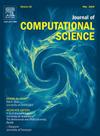Corrosion-induced multiscale damage behavior of ultrahigh strength steel: An integrated simulation and experiment study
IF 3.7
3区 计算机科学
Q2 COMPUTER SCIENCE, INTERDISCIPLINARY APPLICATIONS
引用次数: 0
Abstract
Corrosion is an aggravating problem to cause the premature failure of structure materials, ultimately impacting the safety and operational expenses of equipment. However, the corrosion-induced multiscale damage evolution in the ultrahigh-strength steel is not clearly revealed from atomic scale to macroscopic scale. Here, corrosion-induced multiscale damage mechanism of ultrahigh strength steel plate is investigated using the experiments combined with multiscale simulation, including molecular dynamic simulation, cellular automaton simulation, and phase field finite element method. The experiment shows that the high angle grain boundaries are particularly vulnerable to corrosion, grain refinement takes place during the process of corrosion, and the exposed surface displays significant cracks in the surface of plate. From molecular dynamic simulation, the thickness of the passivation film and the corrosion rate go up with the increasing temperature, which accelerates the early passivation. The corrosion-induced cracks promote the local healing of surface roughness, leading to low strain softening at the nanoscale. By cellular automaton simulation, the passivation film, formed by the corrosion products, serves to hinder the anodic dissolution of the matrix, thereby reducing the average depth of the corrosion pits. Through phase field finite element simulation, the concentration of local strain plays a crucial role in accelerating the rupture rate of the passive film and increasing the corrosion rate at the tip of a pit. Additionally, strong local strains have a significant impact on the longitudinal advancement of corrosion, leading to the progression from a corrosion pit to a crack. These findings not only give a deep understanding of the corrosion-induced cracking behavior, but also provide valuable insights for the development of steel plate with enhanced mechanical properties.
超高强度钢腐蚀致多尺度损伤行为:模拟与试验相结合的研究
腐蚀是导致结构材料过早失效的一个日益严重的问题,最终影响设备的安全性和运行费用。然而,从原子尺度到宏观尺度,腐蚀引起的超高强度钢的多尺度损伤演化并没有得到清晰的揭示。采用分子动力学模拟、元胞自动机模拟、相场有限元等多尺度模拟相结合的方法,对超高强度钢板的腐蚀多尺度损伤机理进行了研究。实验表明,高角度晶界特别容易受到腐蚀,在腐蚀过程中晶粒发生细化,暴露表面出现明显裂纹。分子动力学模拟表明,随着温度的升高,钝化膜的厚度和腐蚀速率均呈上升趋势,加速了早期钝化过程。腐蚀引起的裂纹促进表面粗糙度的局部愈合,导致纳米尺度的低应变软化。通过元胞自动机模拟,腐蚀产物形成的钝化膜阻碍了基体的阳极溶解,从而降低了腐蚀坑的平均深度。通过相场有限元模拟,发现局部应变的集中对加速钝化膜的破裂速率和增大坑尖处的腐蚀速率起着至关重要的作用。此外,强的局部应变对腐蚀的纵向进展有显著影响,导致腐蚀坑向裂纹的进展。这些发现不仅对腐蚀致裂行为有了深入的了解,而且为提高钢板的力学性能提供了有价值的见解。
本文章由计算机程序翻译,如有差异,请以英文原文为准。
求助全文
约1分钟内获得全文
求助全文
来源期刊

Journal of Computational Science
COMPUTER SCIENCE, INTERDISCIPLINARY APPLICATIONS-COMPUTER SCIENCE, THEORY & METHODS
CiteScore
5.50
自引率
3.00%
发文量
227
审稿时长
41 days
期刊介绍:
Computational Science is a rapidly growing multi- and interdisciplinary field that uses advanced computing and data analysis to understand and solve complex problems. It has reached a level of predictive capability that now firmly complements the traditional pillars of experimentation and theory.
The recent advances in experimental techniques such as detectors, on-line sensor networks and high-resolution imaging techniques, have opened up new windows into physical and biological processes at many levels of detail. The resulting data explosion allows for detailed data driven modeling and simulation.
This new discipline in science combines computational thinking, modern computational methods, devices and collateral technologies to address problems far beyond the scope of traditional numerical methods.
Computational science typically unifies three distinct elements:
• Modeling, Algorithms and Simulations (e.g. numerical and non-numerical, discrete and continuous);
• Software developed to solve science (e.g., biological, physical, and social), engineering, medicine, and humanities problems;
• Computer and information science that develops and optimizes the advanced system hardware, software, networking, and data management components (e.g. problem solving environments).
 求助内容:
求助内容: 应助结果提醒方式:
应助结果提醒方式:


